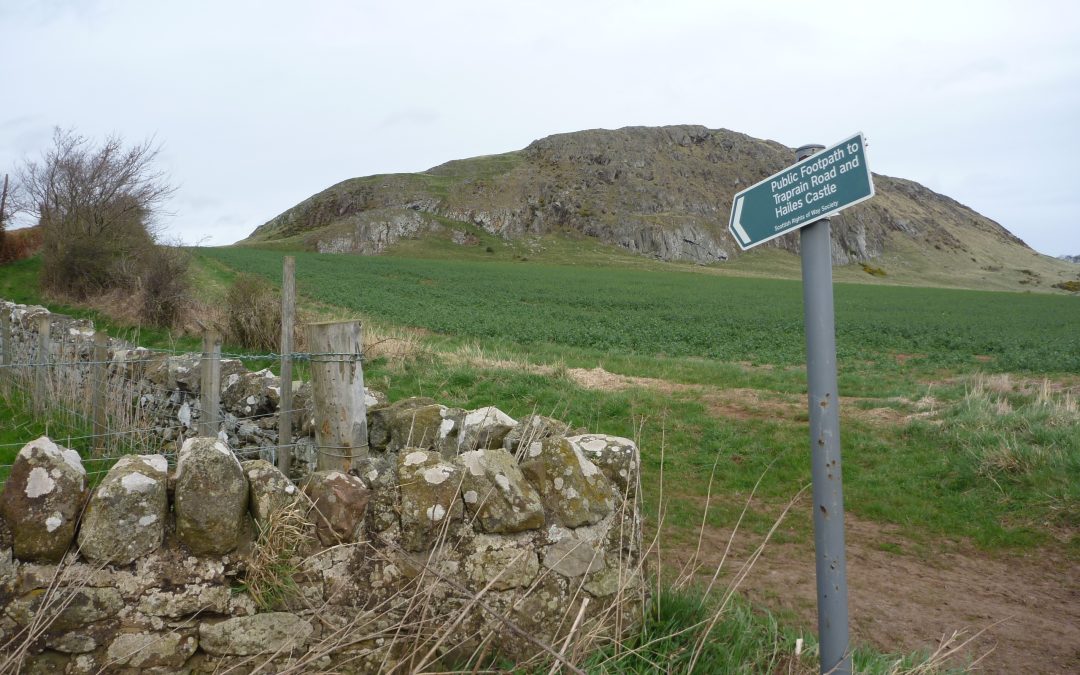Traprain Law is a prominent hill located in East Lothian, Scotland. It is a site of great historical and archaeological importance, with evidence of human activity dating back to the Iron Age. The hill is also home to a number of important monuments, including an ancient hill fort and a series of standing stones.
The name “Traprain Law” is derived from the Old Welsh language, and means “the hill of the boar”. This is believed to be a reference to the wild boars that once roamed the area. Today, the hill is a popular destination for hikers and history enthusiasts alike, offering stunning views of the surrounding countryside and a fascinating glimpse into Scotland’s rich past.
Despite its relatively small size, Traprain Law has played an important role in Scottish history. It is believed to have been the site of a major battle between the Picts and the Northumbrians in the 7th century, and was later used as a royal stronghold by the Kingdom of Northumbria. Today, the hill is a testament to Scotland’s rich cultural heritage, and continues to offer visitors a unique and unforgettable experience.
Geological Formation
Traprain Law is a prominent hill located in East Lothian, Scotland. It is a volcanic feature that was formed during the Carboniferous Period, around 335 million years ago. The hill is composed of phonolite, which is a type of volcanic rock that is rich in alkali feldspar and low in silica.
The phonolite that makes up Traprain Law is believed to have been formed from a laccolith, which is a type of igneous intrusion that is formed when magma is injected into the surrounding rock and then cools and solidifies. The magma that formed the phonolite is believed to have originated from the mantle, and it rose to the surface through a series of fractures and faults in the Earth’s crust.
The phonolite of Traprain Law has a distinctive appearance, with a greyish-white colour and a fine-grained texture. It is also characterised by its high alkali content, which gives it a unique chemical composition compared to other volcanic rocks.
The geological formation of Traprain Law has been the subject of much study and research over the years. It is an important site for geologists and other scientists who are interested in the history of the Earth and the processes that have shaped it over time. The hill is also a popular destination for hikers and tourists who are interested in its unique geology and stunning views of the surrounding countryside.
Historical Significance
Iron Age and Roman Era
Traprain Law in East Lothian has a long and rich history dating back to the Iron Age. The hillfort on the summit of Traprain Law was built during this time and is believed to have been a major stronghold of the Gododdin, a tribe that inhabited the area. The Gododdin were known for their fierce resistance against the Roman Empire, and it is believed that Traprain Law served as a key defensive position against Roman invasions.
During the Roman occupation of Britain, Traprain Law continued to play an important role. The hillfort was likely used as an oppidum, a fortified town that served as a hub for trade and commerce. It was also strategically located near Hadrian’s Wall and the Antonine Wall, two major defensive fortifications built by the Romans to protect their territory.
Medieval Period
In the medieval period, Traprain Law remained an important landmark and was the site of several significant events. According to legend, the hillfort was the location of the Battle of Pren, in which King Lot of the Scots defeated the Angles. The site was also home to a castle known as White Castle, which was built in the 12th century and served as a stronghold for the local nobility.
Today, the historical significance of Traprain Law is recognised by its designation as a Scheduled Ancient Monument. The site is a popular destination for hikers and history enthusiasts alike, offering stunning views of the surrounding countryside and a glimpse into the rich cultural heritage of the region.
Archaeological Discoveries
Traprain Law Treasure
One of the most significant archaeological discoveries at Traprain Law was the Roman Silver Hoard, which was found in 1919 by a farmer ploughing his field. The hoard contained over 5,000 silver coins, spoons, silver plate, and bullion, and was likely buried in the late 4th century AD. The hoard is believed to have been a diplomatic gift from the Roman Emperor Honorius to a local chieftain.
Excavations
Since the discovery of the Roman Silver Hoard, numerous excavations have taken place at Traprain Law. These excavations have revealed much about the history of the site, including evidence of a quarry and a hill fort with impressive ramparts. Archaeologists have also found evidence of metalworking, including evidence of silver being melted down and used to create tableware and jewellery.
In 1919, the Society of Antiquaries of Scotland conducted the first systematic excavation of Traprain Law. The excavation revealed evidence of a hill fort, which was later confirmed by radiocarbon dating to have been built in the 5th century BC. The fort was surrounded by impressive ramparts, which were rebuilt and strengthened several times over the centuries.
In 1947, another excavation revealed evidence of a quarry at the base of the hill. The quarry was likely used to extract the sandstone that was used to build the ramparts and other structures at the site.
Present Day Traprain Law
Traprain Law is a prominent hill located in East Lothian, Scotland. It is a popular destination for tourists and locals alike, offering a range of recreational activities and stunning views of the surrounding area.
Recreational Activities
The hill is a popular destination for walkers, with a number of well-marked trails that provide stunning views of the surrounding countryside. The Ordnance Survey map of the area is an excellent resource for those planning a visit. The hill is also home to a number of wild ponies, which can often be seen grazing on the slopes.
Wildlife
The hill is home to a wide range of wildlife, including wild flowers, birds of prey, and other small mammals. Visitors are advised to take care when walking on the hill, as some of the wildlife can be dangerous if disturbed.
The hill is also a popular destination for photographers, with its stunning views and unique landscape providing a range of opportunities for creative photography.
There are a number of facilities available for visitors to the hill, including car parks, information boards, and a ranger service. The hill is easily accessible by car, bus, or bike, and is located just off the A1 and A199 roads.
The Votadini Tribe
The Votadini were a tribe that inhabited the area now known as East Lothian in Scotland. They were a Celtic tribe and were known for their skilled horsemanship and their ability to trade with other tribes. The Votadini were also known for their fierce resistance against Roman invasion.
Legend has it that the Votadini were descendants of the legendary King Arthur, and that they possessed a magical sword called Excalibur. However, there is no historical evidence to support this claim.
The Votadini tribe was divided into several smaller clans, each with its own chief. The tribe was ruled by a high king, who was chosen from among the chiefs. The Votadini were skilled farmers and also engaged in hunting and fishing.
The Votadini tribe played an important role in the history of Scotland. They were one of the first tribes to resist the Roman invasion of Britain in the 1st century AD. The tribe continued to resist Roman rule for many years, and their resistance was a major factor in the eventual withdrawal of Roman forces from Britain.
National Museum of Scotland
The National Museum of Scotland is a must-visit attraction for anyone interested in the history of Scotland. It is located in Edinburgh and is home to a vast collection of artifacts that tell the story of Scotland’s past. The museum has a dedicated section for Scottish archaeology, including the National Museum of Antiquities.
One of the highlights of the museum is the collection of artifacts from Traprain Law, East Lothian. The museum has a large collection of archaeological finds from the site, including a stunning silver chain, which is considered one of the most important finds from the site. The chain is made up of 44 silver plaques, each with a different design, and is thought to have been made in the 5th century AD.
The museum also has a collection of Pictish stones from the site, including the famous Traprain Law Stone. The stone is decorated with intricate carvings, including a horse and rider, and is thought to date back to the 6th or 7th century AD.
The National Museum of Scotland is a great place to learn about the history of Scotland, and the collection of artifacts from Traprain Law is a fascinating insight into the lives of the people who lived in the area over 1,500 years ago.

